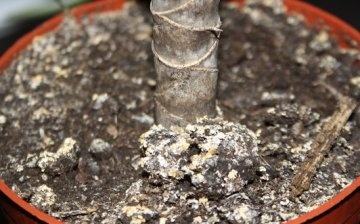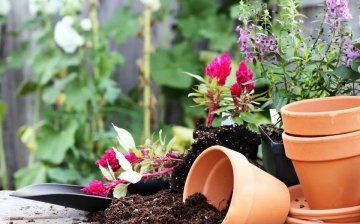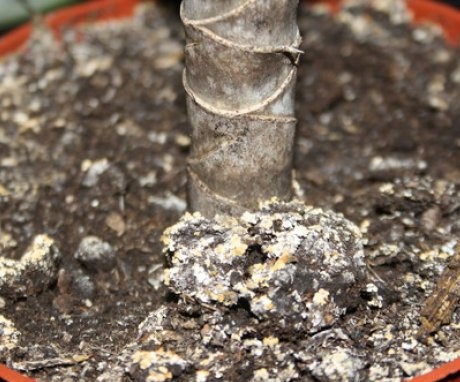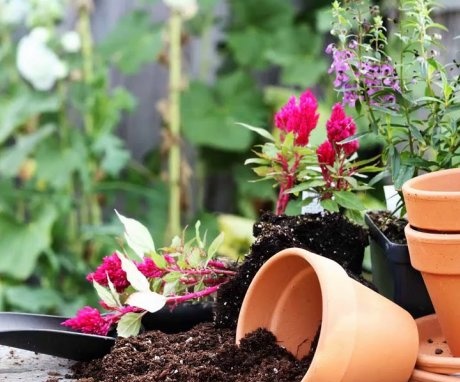The soil in a flower pot is covered with a white coating: why and what to do?
When growing indoor flowers, various difficulties arise. Plants get sick, pests attack them. Mold or white patches are often visible on the potting soil. You can cope with plaque if you know about the reason for its appearance.
Green organisms of indoor plants are sensitive to the living conditions offered to them. Any changes in care are stressful for flowers. You can notice the irregularities of the cultivation by the state of the soil in the flower pot. If a white bloom appears on top of the soil, then it is necessary to check whether all the rules for caring for the plant are followed.
Content:
- Causes of the appearance of white plaque
- What to do: ways to get rid of white plaque
- How to avoid the appearance of white bloom on the ground?
Causes of the appearance of white plaque
There are two types of white bloom on top of the soil of a flower pot. The first is associated with the deposition of salts. It is harsh and calcareous to the touch. Its appearance is associated with the illiterate care of the plant:
- Excessive watering leads to the fact that moisture evaporates more actively from the surface of the earth, leaving salts on it.
- A rare and poor soil moisture leads to the fact that only the top layer of the earthen mixture is impregnated. Hence the white bloom after evaporation of the liquid.
- In winter, the dryness of the indoor air stimulates the drying process of the soil in the container. Salts in the irrigation water are not discharged outside, remaining on the surface. Hence the salinity of the soil. Houseplants wither from this, develop poorly.
- Overfeeding flower mineral fertilizers leads to the formation of a white coating.
- The selection of the volume of the flower pot plays an important role for the plants at home. The spacious container will prevent the roots from absorbing moisture and nutrients. Their surplus will appear in the form of salt deposits.
- If the composition of the soil is heavy, it contains a lot of acids, and there is no drainage layer in the pot, then a white bloom will appear in the pot.
- In city apartments, hard water flows from the tap. If she is watered with indoor flowers, then the appearance of a white bloom is inevitable.
Plaque, fluffy and moist, on the ground in a pot indicates that the soil is infected with pathogenic fungi. An ideal condition for the development and spread of fungal spores is an increased humidity in the room over 85-90 percent and a temperature of 20-25 degrees Celsius. For the spread of the fungus, stagnant air is needed, the absence of sunlight. White mold is harmful to plants. If you do not take action, the plant will die. Limescale is easier to deal with than mold.
What to do: ways to get rid of white plaque
It is necessary to remove white bloom as soon as it is found on the ground in a pot:
- You can heal the soil in a pot by loosening the top layer. After that, it is recommended to add fresh soil, into which a little river sand is added.
- Refresh the soil in the pot by removing the top layer and filling it with disinfected soil containing humus.
- If soil acidity in the pot is increased, then, after removing the upper part of the substrate, a deoxidizer is poured. It can be chalk, dolomite flour, wood ash.
- After replacing the top layer with a white bloom with a new one, it is necessary to irrigate correctly, apply fertilizers according to the instructions for their use.To soften hard tap water, it is poured into containers and defended for a day - two.
- You can get rid of mold by spraying plants fungicides three times with a break of 10-14 days. Drying of the soil will temporarily stop the spread of mold spores. You can sprinkle the soil in the pot and crushed activated carbon. The powder will help stop the growth of the fungus.
- If the mold is highly developed, it is better to transplant the flower into another container. It is imperative during the procedure that the rotting parts of the roots are cut off, treated with a solution of potassium permanganate.
How to avoid the appearance of white bloom on the ground?
Only competent care of the plant, taking care of it will help to avoid the formation of a lime layer on the soil:
- Indoor flowers are watered depending on the period of the plant's life. During the growing season, moisten from two to three times a week, well soaking the soil in the pot. If the top layer is still wet, then it is better to postpone watering. Water for irrigation is prepared in advance. It should be at room temperature, separated. You can drive it through the peat layer to soften.
- Plants need a constant supply of fresh air. When airing the room, make sure that the flower pots are not in a draft. Sunbathing is essential for all green people at home. But their duration is determined for each plant individually.
- A plant transplant is organized when it is sick or the pot has become small for it. The procedure will help improve the growing conditions of the indoor flower.
- Disinfection of a new container and soil prepared for the plant is required. After all, this will lead to a halt in the development of pathogenic flora inside the container. The drainage layer will help remove excess moisture from the pot.
In addition, in the room where your favorite plants "live", you must observe the temperature regime, ventilate them as needed.
More information can be found in the video:














This is a commonplace mold. Erosion is possible. Now is the time to transplant such a flower in the spring. Buy soil from the supermarket, carefully remove the flower, rinse the roots with a special solution and plant in a new pot. Old, if clay, also process.
What if there is only very hard water in the house? Of course, we defend it before watering, nevertheless, it is especially softer, the water does not become from this, we cannot always collect rain.